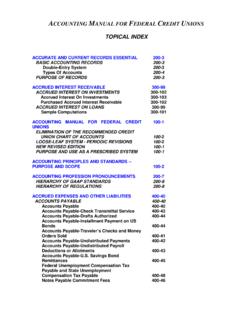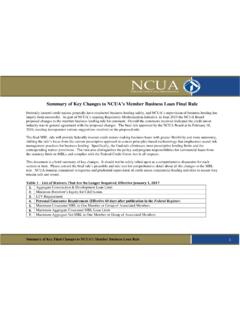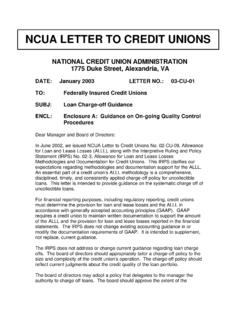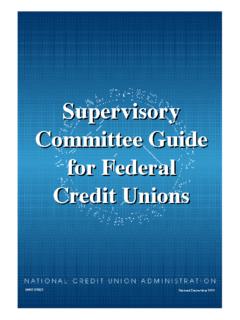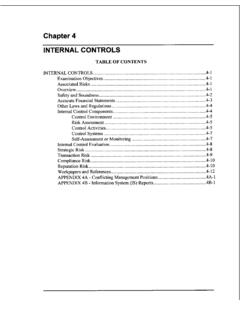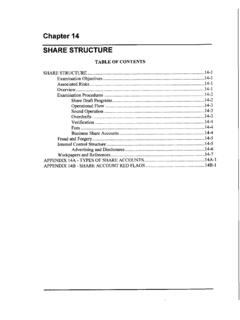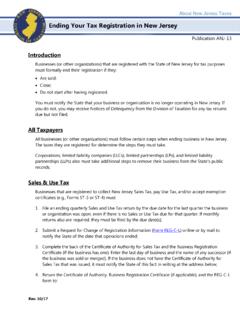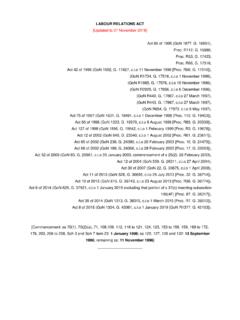Transcription of Chapter 16 NET WORTH AND OTHER EQUITY ACCOUNTS
1 Chapter 16 NET WORTH AND OTHER EQUITY ACCOUNTS TABLE OF CONTENTS NET WORTH AND OTHER EQUITY ACCOUNTS .. 16. 1 Examination Objectives .. 16-1 Overview ..1 GAAP vs . RAP .. 16-6 OTHER Considerations .. 16-7 Undivided Earnings .. 16-8 Associated Risks .. 16. 1 Secondary Capital for Community Development Credit Unions .. 16-4 Capital and Solvency Evaluation .. Regular Reserve .. 6-9 Accumulated Unrealized GainsLosses on Available for Sale Securities .. 16-9 Workpapers and References .. 16-9 Chapter 16 NET WORTH AND OTHER EQUITY ACCOUNTS Examination 0 Objectives 0 0 0 0 0 0 Determine whether the credit union complies with Regulation D, if applicable Ascertain compliance with the Credit Union Membership Access Act (CUMAA) Determine whether the credit union has sufficient net WORTH for its degree of risk Determine whether the credit union has adequate policies, practices, and procedures regarding net WORTH and capital ACCOUNTS Determine if officials and employees adhere to established policies, practices, and procedures regarding net WORTH and capital ACCOUNTS Determine whether reserve ACCOUNTS are audited periodically Determine whether reserve ACCOUNTS comply with the CUMAA, FCU Act, NCUA Rules and Regulations, and appropriate accounting guidance Determine if the credit union promptly corrects deficiencies or violations noted during examinations or audits Associated Risks risk investments; Credit risk can result from poor underwriting of loans or high- Interest rate risk can result from insufficient net interest margin to cover operating expenses.
2 Liquidity risk can result from inadequate pricing policies, and failure to properly structure share and loan products resulting in weak or negative profitability; Strategic risk can result from failure of management to plan for sufficient resources to fulfill business plans or continue offering competitive products and services; Transaction risk can result from failure to establish and implement policies and procedures that ensure the accuracy and integrity of data and information; Compliance can result when credit unions fail to comply with applicable laws and regulations; and 0 0 0 Page 16-1 EXAMINER S GUIDE Overview Reputation risk can result from loss of member confidence and withdrawal of member shares due to questions regarding the credit union s on-going viability. The adequacy of the credit union s reserves should correlate to the amount of risk it has taken or plans to take. Two types of reserves apply to credit unions: cash reserves and EQUITY reserves.
3 Cash reserves include transaction account reserves required by Regulation D. Credit unions hold cash reserves in the following forms: Vault cash; A balance maintained directly with the Federal Reserve Bank (FRB) in the District in which the credit union is located; or A pass-through account, which is considered a balance maintained with the FRB. Cash reserves usually do not apply to smaller credit unions; however, EQUITY reserves apply to all credit unions. Credit unions establish EQUITY reserves (also called capital) by segregating part of their net income into reserve and undivided earnings ACCOUNTS . EQUITY reserves may be either appropriated or unappropriated. A credit union s capital is defined as the total of its regular reserves, allowance for loan and lease losses, special reserves, undivided earnings, accumulated unrealized gains or losses on available-for-sale (AFS) securities, and that portion of year-to-date net income that has not yet been closed to the appropriate capital account.
4 Capital ACCOUNTS provide (1) a cushion for anticipated and unidentified losses, (2) a base for future growth, and (3) a means by which the credit union can meet competitive pressures as they arise. Capital provides the credit union a cost-free source of funds. Net WORTH is defined as the retained earnings balance of the credit union at quarter end as determined under generally accepted accounting principles (GAAP). See the FCU Act 216(d)(o)(2). Retained earnings consist of undivided earnings, regular reserves, and any OTHER appropriations designated by management or Page 16-2 NET WORTH AND OTHER EQUITY ACCOUNTS regulatory authorities. Net WORTH does not include the Allowance for Loan and Lease Losses account. This means that net WORTH only includes undivided earnings and appropriations of undivided earnings. (Refer to the Prompt Corrective Action Chapter of this Guide for additional information.) A strong net WORTH position enables a credit union to take on more risk than can a credit union with a weak net WORTH position.
5 A stronger overall net WORTH position better enables a credit union to deal with future uncertainties such as asset losses, sponsor layoffs, and adverse economic cycles. The credit union board should have a plan for defining and maintaining an adequate net WORTH level. The examiner should review the net WORTH position and the officials' philosophy toward building and maintaining net WORTH . If the net WORTH position does not meet the credit union's short- or long-term needs, the examiner should determine if the shortfall poses a threat to safety and soundness. Examiners may find the following ratios useful in reviewing capital and net WORTH : Net WORTH to Assets; Net WORTH Growth vs. Asset Growth (trend); Capital to Assets; Net Capital to Assets; Capital Growth to Asset Growth; Net WORTH to Loans; Classified Assets to Net WORTH ; Total Delinquent Loans to Net WORTH ; and Solvency Evaluation. When analyzing the adequacy of reserves and net WORTH , examiners should consider the following factors: 8 Size of the credit union; 8 Complexity of products and services; Degree of sponsor support; Level of management's expertise; Page 16-3 EXAMINER S GUIDE 0 Quality of management s due diligence for existing and new products, services and systems; Involvement of the officials; 0 Interest rate risk; 0 Internal control structure; 0 Stability and diversity of the field of membership; and 0 Concentrations of credit and savings.
6 Examiners should also consider the amount of coverage provided by the credit union s surety bond. (a) of the NCUA Rules and Regulations defines the minimum coverage required. Some of the newer bond forms provide significantly less coverage than the standard bond. Examiners should ensure the credit union maintains adequate bond coverage. See the Bond Coverage Chapter of this Guide for additional guidance. Secondary Capital for Community Development Credit Unions Federally insured credit unions designated as low-income may establish secondary capital ACCOUNTS , which examiners should review for compliance with (b) of the NCUA Rules and Regulations. Before offering secondary capital ACCOUNTS , the credit union must adopt, and forward to the appropriate regional director, a written plan for use of the secondary capital account funds and subsequent liquidity needs to meet repayment requirements upon maturity of the ACCOUNTS .
7 The following restrictions apply to these secondary capital ACCOUNTS : 0 Establishment as an uninsured secondary capital account or OTHER form of non-share account; 0 Minimum five years maturity; 0 Not redeemable before maturity; Not insured by the National Credit Union Share Insurance Fund (NCUSIF) or any governmental or private entity; Page 16-4 NET WORTH AND OTHER EQUITY ACCOUNTS 0 Holder s claim against the credit union is subordinate to all OTHER claims, including those of shareholders, creditors, and the NCUSIF; Required availability of funds deposited, including interest accrued and paid into the secondary capital account, to cover credit union s operating losses that exceed net available reserves and undivided earnings ( , exclusive of allowance ACCOUNTS for loan and lease losses.) Credit unions may not replenish the account for funds so used. Credit unions may pay interest accrued on the secondary capital account directly to the investor - or into a separate account available to the investor for withdrawals.
8 Pro-rata distribution of realized losses among all secondary capital ACCOUNTS held by the credit union is required; 0 May not pledge as security on a loan or OTHER obligation with the credit union or any OTHER party; Account funds not needed for covering losses at the time of merger ( OTHER than merger into another low-income designated credit union) or voluntary dissolution will be closed and paid out to the account holder; Contract containing terms and conditions required between representative of the account holder and the credit union; and Disclosure and acknowledgment signed by representative of account holder is required and the account holder will receive copies of contract and disclosure at the time of entering into the account agreement (see the Appendix to of the NCUA Rules and Regulations.) Credit unions must retain original copies of the contract and the disclosure and acknowledgment for the term of the agreement.
9 The regulation establishes a declining scale for the capital value of ACCOUNTS with less than five years remaining maturity. Even so, all funds will continue to be at risk to cover losses that exceed reserves and undivided earnings. The declining scale addresses ACCOUNTS with remaining maturities of at least the following: Page 16-5 EXAMINER S GUIDE Four years, but less than five years - counted as capital at 80 percent of face value; Three years, but less than four years - counted as capital at 60 percent of face value; Two years, but less than three years - counted as capital at 40 percent of face value; One year, but less than two years - counted as capital at 20 percent of face value; and Less than one year remaining maturity - counted as capital at 0 percent of face value. Examiners should review the disclosure and acknowledgment that the account holder s authorized representative must provide and execute. (See disclosure in the Appendix to of the NCUA Rules and Regulations.)
10 GAAP vs. RAP GAAP classifies secondary capital ACCOUNTS as subordinated debt. As such, the account holder does not have voting or ownership rights. However, NCUA adopted a regulatory accounting position (RAP) that recognizes secondary capital ACCOUNTS for low-income designated credit unions as capital ACCOUNTS . This RAP position applies to all credit unions having a low-income designation, including those with assets equal to or greater than ten million. Examiners should understand that the credit union s outside auditor may recognize these ACCOUNTS as subordinated debt, and reflect the entire balance in these ACCOUNTS in the liability section of the balance sheet consistent with GAAP for financial statement presentation. Examiners should record secondary capital as OTHER Revocable Reserves in the EQUITY section of the balance sheet to ensure their inclusion in capital when AIRES calculates CAMEL component and composite ratings.
